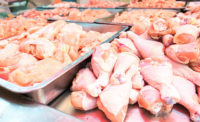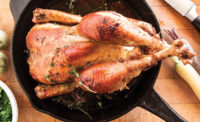Making the Right Chicken
BY TOM WRAY, ASSOCIATE EDITOR
Bell & Evans keeps its focus on producing products that its employees and customers would want to eat.
Why would a company with more than a century of producing quality poultry change its whole way of processing to a method rarely used in this country?
Because it really believes in what it does.
At heart, that’s the reason why Bell & Evans has changed its methods to produce natural chicken using no antibiotics and vegetarian feed and using air-chilling in the processing.
“We feel the best thing we can do is continually improve the product,” says Tom Stone, the director of marketing for Bell & Evans, which is located in Fredericksburg, Pa.
The company has been in business since the 1890s and always had a reputation for producing quality chicken. The quality continued when Scott Sechler bought Bell & Evans from the founding families, but how that quality came changed a bit.
“Scott’s focus when he took over was to improve the process,” explains Stone. Sechler had sold chickens as a young man and bought the company in 1984 at the age of 24.
The corporate name is Farmers Pride Inc., which is also the name of the company’s non-natural chicken products. Farmers Pride had been doing private-label processing of Bell & Evans chickens, under stringent specifications, since the 1950s. The two were merged in 1986 after Sechler bought Farmers Pride in 1984 and the Bell & Evans brand in 1986.
Since then, the focus has been on raising the best possible natural chickens. That focus starts at the farm. Bell & Evans uses contract farmers, like most poultry processors. “They own the farms,” says Stone of the farmers. “We own the birds, the feed, litter and propane to heat the houses.”
Those items are important in making sure that the chickens are as healthy as possible. Feed is at the core of that. The company makes a point not to use hexane gas-separated soy meal for feed. That standard started after Sechler once opened a trailer with feed early in his ownership of the company. “He got hit with the smell of gasoline,” continues Stone. “He made it his life goal to eliminate hexane in feed.” Not using hexane in the process is also, ultimately, better for the consumers.
None of the chickens are given antibiotics if they’re to be sold under the Bell & Evans name. It was an effort that took Sechler four years after he bought the company, but was also one of the company’s first accomplishments. It also requires careful raising of the poultry.
“You have to have very clean, sanitary conditions,” says Stone. “That’s why we remove the manure after every flock.” They are also careful with the breeder stock, to ensure a history of health from the egg to the chicken. Bell & Evans also requires that the chickenhouses have concrete floors and dedicated feed trailers to prevent mixing with lower quality feed. The company has also done testing for avian flu of flocks for more than 20 years.
Sometimes, despite the best of efforts, the flock will get sick. The company will treat the flock with antibiotics, but then they are no longer considered “natural.” “We will sell those under our other brand, but they’re never processed as Bell & Evans,” states Stone. “We just can’t let them die.” The company even uses an animal welfare committee to go out to the farms to focus what’s done at the farm level to ensure the chickens are treated as humanely as possible.
Quality assurance doesn’t stop with the farm. It continues in the processing plant. “We feel the best thing we can do is continually improve the product,” Stone says. In 2006, Bell & Evans started using an air-chill system. The process uses a series of chambers kept at a certain temperature and humidity and is more common in Europe than the United States, where water chilling is more commonly used.
“We weren’t the first,” Stone admits, “but we waited to find the right way. It makes a big difference in the flavor of our products.” Bell & Evans had actively researched the process for 20 years before finally developing the unique one-level system at a cost of $10 million. The chickens will cross almost two miles of track and take more than two and a half hours to go through the system. The one-level design prevents cross-contamination from drips from birds on different levels. By the time the chickens are all they way through, they’ve been chilled down to 35 degrees without being frozen or soaking up water that can add up to 8 percent of the chicken’s body weight.
“It has a great taste,” says Stone. “It has only the natural juices of the chicken.” And the process saves the thousands of gallons of water normally used in chilling process.
To ensure no contamination happens at any point in the process, Bell & Evans uses a USDA-approved anti-microbial system. The antimicrobial is organic and citrus-based while destroying 99 percent of bacteria such as Listeria, Salmonella, E. coli and Campylobacter.
Now the company is working on building a new kill building with completion projected for 2008 or 2009. “We’re going out and researching the best and most humane way to do that,” he says. “That’s our next [goal].”
Most of Bell & Evans’ chickens are sold fresh, but the company does produce some convenience foods, including items such as chicken burgers, grilled chicken, chicken pesto and chicken alfredo. The company has started to distinguish itself with the introduction of gluten-free, breaded chicken products.
Going Gluten-free
Gluten protein is found in wheat flour, the usual breading for many prepared, breaded chicken products. However, people with the autoimmune Celiac disease, are unable to eat gluten. For them, it can cause severe health problems. “We decided to produce something for that market,” says Stone.
He says the company will be unveiling four new breaded chicken products this summer using rice flour. Even in advance of the debut, the response to the company’s new products has been strong.
“We get these emails from people, and [the response is] amazing,” Stone continues. The company has also started to work with the National Foundation for Celiac Awareness (NFCA). “We’re interested in working together with them to get people tested,” says Stone.
Stone goes onto say many people can go through years of suffering before being diagnosed with the genetic disease. He points out that Alice Bast, the executive director of the NFCA, suffered from miscarriages and hair loss until her diagnosis. “When she was diagnosed, her life turned around,” he says.
“We do it because it’s the right thing to do,” says Stone. “That’s Scott’s motto.”
Like the other products from the company, a lot of care goes into making the items. The gluten-free chicken is sold in black boxes distinct from the company’s usual blue. While made at the same factory as regular chicken nugget and tenders, workers go to great lengths to make sure that there is no cross-contamination between the two types of breading.
Workers are trained in the handling of allergenic materials such as the milk, eggs, soy beans, wheat and gluten. All ingredients containing allergens are tagged and separated from each other and the packing material. Gluten-free products are made at the beginning of the shift and only after cleaning and sanitizing and using fresh non-hydrogenated vegetable oil in the product.
Bell & Evans also has a few atypical products. Along with chicken, and some turkey, the company also sells Cornish game hens and duck meat under its banner. “Those are produced for us by other companies, on our strict controls on raising and feeding,” says Stone. The organic chickens come from Eberly Farms, a company that Bell & Evans has a long relationship with.
Luckily, all of those products are relatively easy to find across the country. They started selling in natural and organic grocery stores through Bread & Circuses in Boston. “They were just looking for a great chicken, and we had a great rep in the Northeast,” Stone says.
Its growth has continued. Bell & Evans started distribution through retailer Whole Foods back in 1990, before the chain became one of the movers in a now rapidly growing segment. As Whole Foods grew and acquired many of the regional stores, Bell & Evans went with it. The A&P grocery chain, a traditional retailer, started to carry the brand in early April. “We’re eager to see how they work out,” Stone says. The chicken, now available in 41 of the lower 48 states, is sold frozen in all stores and fresh east of the Mississippi River.
The Human Element
Bell & Evans hasn’t forgotten about the human element. The company is currently building a new cafeteria for its employees that will serve all-natural food. “It’s the first of its kind,” Stone proudly states. It also has a staff of 18 people solely focused on employee support.
Stone admits that the company is small compared to the big boys. But the company doesn’t seem to be worried about the new natural and organic lines coming from the big processing companies. “It’s interesting seeing the big companies coming out with a secondary or tertiary label,” Stone says. “Either you believe in it or you don’t. That’s why we raise all our chickens this way.”
He does agree that the natural food market is growing. He uses celebrity chef Wolfgang Puck, who recently announced that his restaurants will use naturally raised meats, as an example. Popular casual dining chains Chipotle Grill and Panera Bread have already started using naturally raised meats.
“It almost seems to be going back to where things used to be,” Stone continues. “Instead of being so focused on producing as much as quickly as possible, the industry is paying more attention to how it’s raised.”
It all comes down to one simple idea, according to Stone, “We want to produce something we want to eat.”
Bell & Evans (Corporate name: Farmers Pride, Inc.)
Founded: mid-1890s
Headquarters: Sedan, Kan.
Sales: $175 million
Employees: 1,200
Plants: 1
Brands: Bell & Evans, Farmers Pride
Web: www.bellandevans.com
Founded: mid-1890s
Headquarters: Sedan, Kan.
Sales: $175 million
Employees: 1,200
Plants: 1
Brands: Bell & Evans, Farmers Pride
Web: www.bellandevans.com



Report Abusive Comment